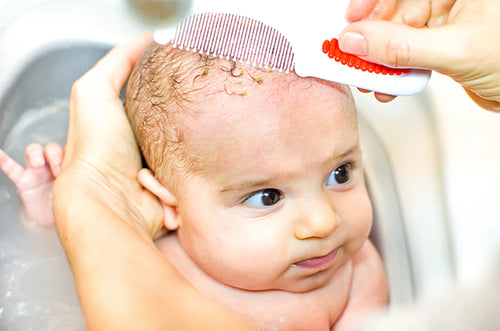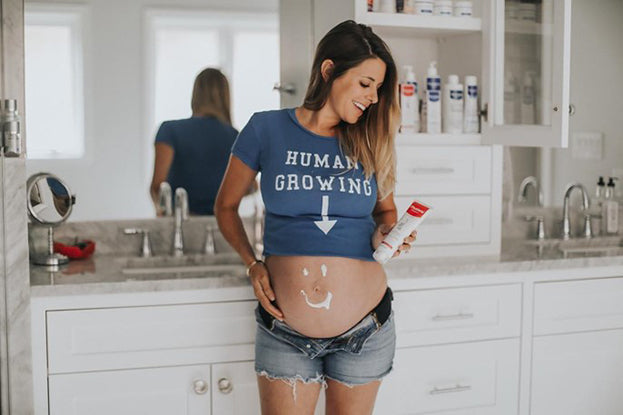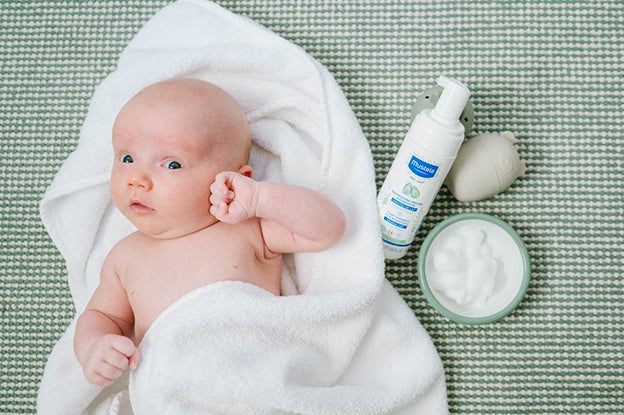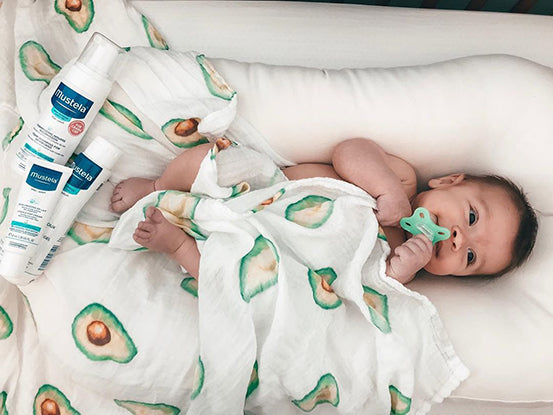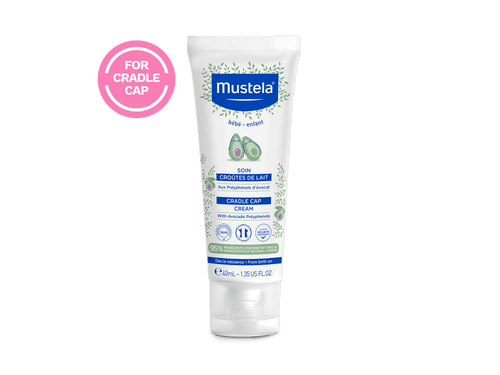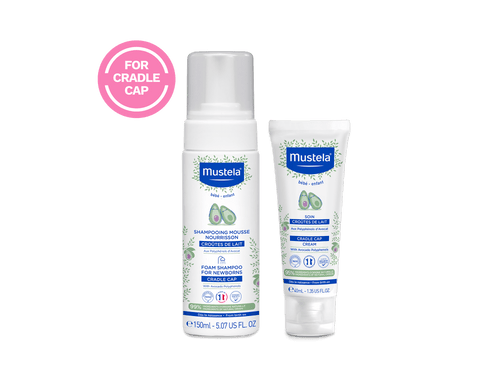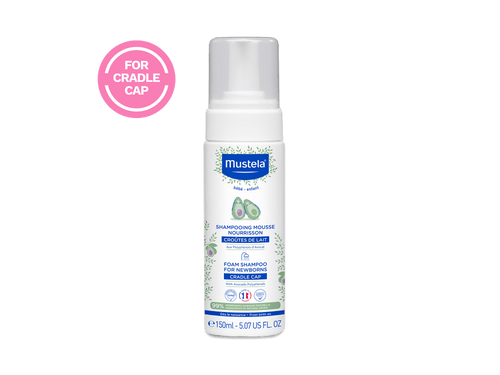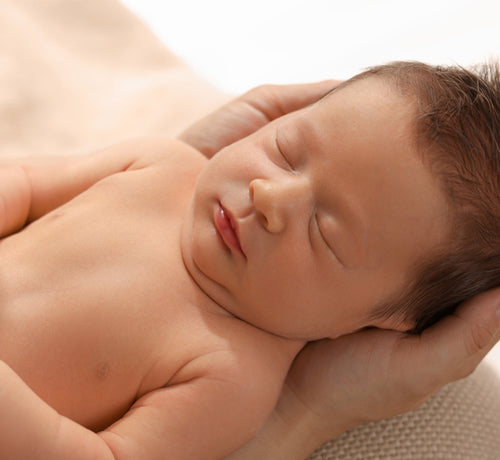If your baby has flaky, crusty patches of skin on their scalp, chances are they have a cradle cap, a common newborn skin condition. And while it may look alarming, rest assured that it’s not harmful. But as a parent, you may be wondering what causes cradle cap in the first place.
In this guide, we’ll look at potential causes for this flaky skin and provide tips on managing it. But first, let’s talk about what cradle cap is and what symptoms you may notice.
Table Of Contents
- What Is Cradle Cap?
- Cradle Cap Symptoms
- What Causes Cradle Cap: Known Facts
- What Causes Cradle Cap: Potential Triggers
- How To Treat Cradle Cap
- When To See Your Doctor
What Is Cradle Cap?

Cradle cap, also known as infantile seborrheic dermatitis, is a scaly rash that can appear on oily areas of the body. In infants, it most often occurs on their scalp.
However, it can also develop on the:
- Forehead
- Back of the ears
- Armpits
- Skin folds in the diaper area
- Back of the knees
No matter where the symptoms appear on the body, it’s still called cradle cap.
Cradle Cap Symptoms
The first symptom you’ll likely notice is thick, crusty skin on your baby’s scalp. It may be in only a spot or two or all over their head. The patches are usually white or yellowish and are greasy or oily to the touch.
- Other symptoms of cradle cap may include:
- Noticeable flakes in the hair
- Bumpy skin
- Itchiness
- Color changes on the scalp (often red or yellow)
- Hair loss
If the cradle cap spreads to other parts of your baby’s body, you may also notice:
- Red, moist patches in skin folds
- Greasy spots
- Crusty or scaly skin
Though it looks unsightly, cradle cap doesn’t typically cause pain. It is, however, occasionally itchy.
Other Similar Conditions
Cradle cap isn’t the only skin condition that can cause flaky skin. Here are some other possibilities:
- Eczema: This chronic skin condition may cause dry, red, itchy patches of skin on the face, hands, or other body parts. It can also affect the scalp.
- Psoriasis: Itchy, scaly, raised patches are symptoms of this chronic skin condition. Your baby may also experience discomfort or burning pain in the affected areas.
- Dry skin: Your baby’s skin is prone to dryness. While dry skin and cradle cap cause similar symptoms, the flaky areas won’t feel greasy if it’s dry skin.
Since these conditions are similar, it can be difficult to tell them apart. If you’re not sure what’s causing your little one’s flaky scalp, their doctor can examine your little one and give you a diagnosis.
How Long Does Cradle Cap Last?
Cradle cap starts early in life, often in babies between 2 – 6 weeks of age. But don’t worry — it’s not permanent. Most infants outgrow this condition by their first birthday.
It can go away even faster with treatment (which we’ll talk about later.)
What Causes Cradle Cap: Known Facts
Unfortunately, experts aren’t exactly sure what causes cradle cap. Several theories exist, but no definitive answer has been found.
Here’s what is known:
- Cradle cap is not contagious.
- It’s not a sign of bad hygiene.
- It’s not an allergic reaction.
Scientists may eventually determine what causes cradle cap. Until then, we’ll have to rely on their theories about this condition.
What Causes Cradle Cap: Potential Triggers
Let’s look at some of the potential causes of cradle cap. These are all things that researchers suspect play a role in its onset.
Hormones
Before your baby was born, they were exposed to all sorts of hormones in utero. If you’re breastfeeding, you’re still transferring some hormones to your baby.
These hormones can cause your baby’s oil glands to become overactive. When that happens, their body produces more sebum than usual.
Then, as their dry skin flakes off, it sticks to the extra oil instead of falling off unnoticed. Over time, these stuck flakes build up into crusty patches.
A Common Yeast
Malassezia is a type of yeast that’s present on everyone’s skin. It feeds on the oils and sebum that the skin naturally produces. When it grows out of control, it can contribute to cradle cap.
Skin Microbiome Imbalance
When you kiss your baby’s soft skin, you likely don’t think about how many millions of living organisms are on it. But it’s true. Humans all have a microbiome — an ecosystem of sorts — on their skin and in their bodies.
When the balance of good and bad bacteria is off-kilter, issues like cradle cap can arise.
How To Treat Cradle Cap
Now that you know more about what causes cradle cap, let’s talk about how to treat it.
Implement A Simple Hair Care Routine
Consistency is key when treating cradle cap. Implement a simple hair care routine and stick with it to help improve their scalp over time.
Here’s a sample routine to try:
- Give your baby a quick daily bath with Foam Shampoo for Newborns to gently cleanse their scalp and loosen the flakes.
- While they’re still in the tub, gently massage your baby’s scalp with a soft brush or washcloth to help remove the crusty skin.
- Rinse their hair thoroughly.
- Pat their skin dry with a soft towel.
- Before bed, apply Cradle Cap Cream to the affected areas. Rub it in and let it stay on all night.
Moisturize Carefully
If you’re having trouble removing the patches, rub a small amount of natural oil (like coconut oil or sunflower oil) on the affected areas. This can help loosen things up so the flakes come off more easily during bath time.
But be careful not to over-moisturize. Your baby’s scalp already has excess oil, so adding too much more could worsen the cradle cap.
It’s best to do this right before their bath so you can get the softening benefits without leaving extra oil on their head for too long.
Choose Gentle Products
Since your baby’s skin is delicate, choosing gentle products that won’t further irritate their scalp is important.
Look for formulas that are:
- Fragrance-free
- Made from naturally derived ingredients
- Tested by dermatologists and pediatricians
- Free from parabens, phthalates, and phenoxyethanol
Mustela offers a variety of gentle products that fit these criteria, including their Cradle Cap Duo. This bundle includes Cradle Cap Cream and Foam Shampoo for Newborns, giving you a powerful combination to treat your baby’s scalp.
Leave It Alone
As tempting as it is to sit and pick the flakes off your baby’s head, please don’t. Scratching or picking at the cradle cap can irritate the area and lead to infection. Plus, it’s not a pleasant experience for your little one.
Instead, remember that this is a temporary condition that won’t cause long-term problems. Stick with the hair care routine outlined above and continue to monitor the situation.
Cradle cap usually clears up within a few weeks or months. Before then, your baby’s hair might grow enough to cover the area, making the flakes barely noticeable.
When To See Your Doctor
While most parents can treat cradle cap at home, there are times when it’s best to seek advice from your pediatrician.
Here are some signs that it’s time for a professional opinion:
- The cradle cap gets worse despite your best treatment efforts.
- Your baby is running a high fever or their scalp becomes red, swollen, or oozes pus. (These are all signs of an infection.)
- Your baby seems uncomfortable or in pain from the cradle cap.
- You’re concerned about your baby’s condition.
Your doctor may examine your baby’s scalp and verify the diagnosis. They may also recommend using specific products to treat the area. In severe cases, they may prescribe a steroid cream.
Say Goodbye To Cradle Cap
As we wrap up this guide about what causes cradle cap in babies and how to treat it, we hope you feel more informed and confident about dealing with this common condition.
Let’s quickly review a few key takeaways:
- Cradle cap is a common and typically harmless condition in babies that results in scaly patches of skin, mostly on the scalp.
- Experts don’t know for certain what causes it, but it can be triggered by the mother’s hormones, yeast, or skin microbiome imbalance.
- It can be managed with gentle hair care routines that include Foam Shampoo for Newborns and Cradle Cap Cream.
- If the cradle cap persists or causes concern, consult with your pediatrician.
And remember — cradle cap is temporary. With proper care and treatment, it won’t last long. So pick up the Cradle Cap Duo from Mustela and say goodbye to those pesky flakes and scales!


